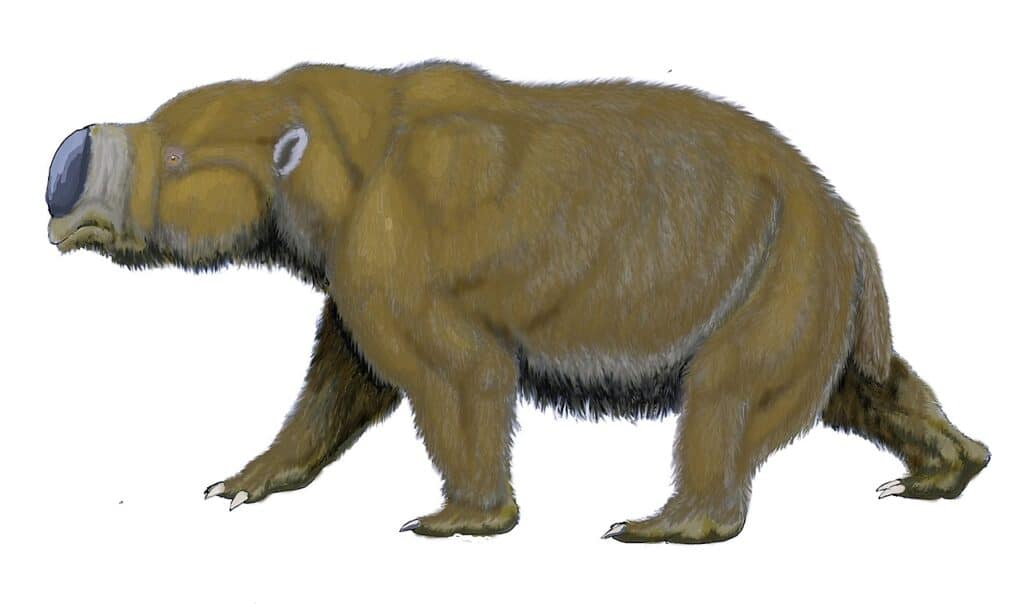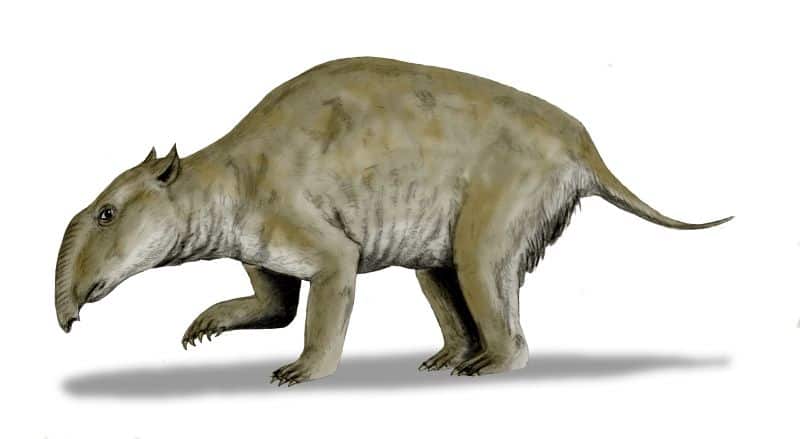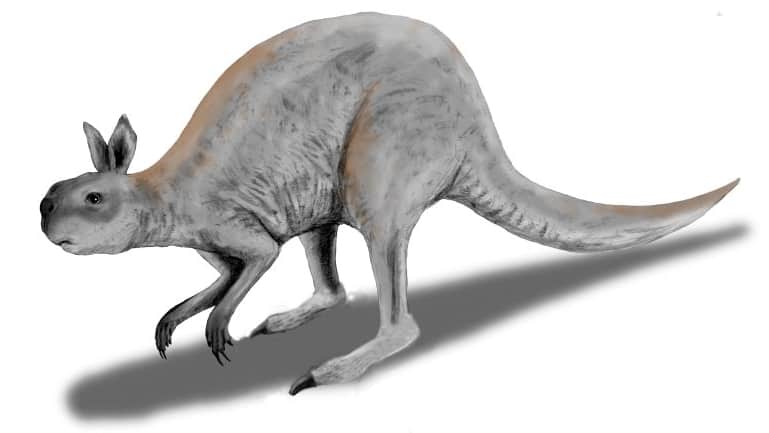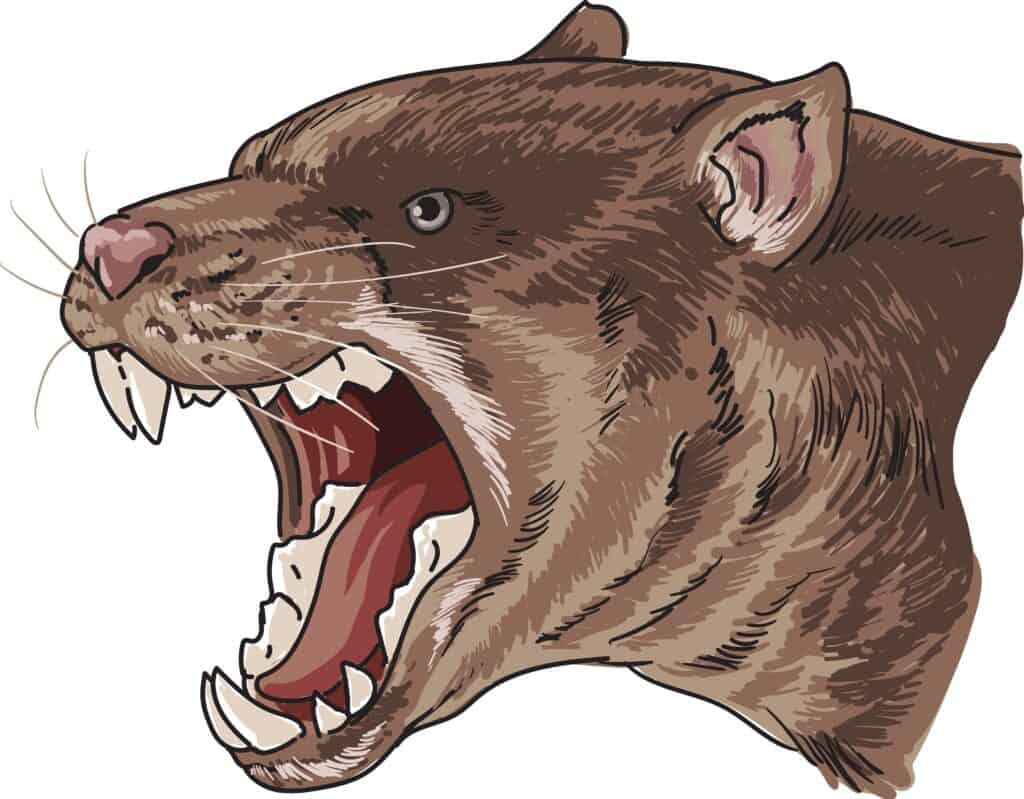Koalas and kangaroos are well-known Australian animals, as are wombats and wallabies. All these animals have two things in common. First, they are marsupials, and second, they exist today. But what about the five largest marsupials ever discovered in the past?
What Are Marsupials?
Marsupials give birth to an undeveloped fetus. After birth, the fetus crawls into its mother’s pouch or marsupium, where it continues developing until it can live independently. Marsupials mostly live in Australia, but some species, like the opossum, occupy parts of the Americas. At present, the red kangaroos of Australia are the largest living marsupials. However, we must examine the past regarding the largest marsupials ever discovered.
Largest Marsupial – Diprotodon Optatum or the Giant Wombat

This
Diprotodon optatumis one of the largest marsupials ever to walk the earth. It stood about 6 feet tall, was 11.5 feet long, and weighed approximately 2.5 tonnes.
©Dmitry Bogdanov / CC BY 3.0 – License
One hundred thousand years ago, a giant walked the earth. This colossal beast stood about 6 feet tall and was 11.5 feet long. Scientists estimate that this giant wombat weighed approximately 2.5 tonnes.
Diprotodon optatum lived in what we know today as Australia during the Pleistocene era (Ice Age – approximately 2,580,000 to 11,700 years ago). For example, scientists have found fossils in the creek beds of the far south and the coasts of the far north.
These findings make the giant wombat among the most well-known and widespread examples of megafauna species. Megafauna is a word that scientists use to describe massive creatures living in a region, geological period, or habit, whether extinct or alive.
Additionally, scientists discovered that Diprotodon optatum fossils all belong to one species. In contrast, they previously thought two species of distinctly different sizes existed. However, researchers learned that sexual dimorphism now explains the difference in their discoveries of fossil sizes.
Despite these findings, experts presently know very little about the Diprotodon. However, they continue to uncover new data daily, which is intriguing. For instance, like most mammals where sexual dimorphism is present, the males of the species did their own thing. At the same time, the females stayed in groups and raised their young together.
Palorchestes or the Marsupial Tapir

resembled a tapir, weighed up to 2,200 pounds, went extinct about 40,000 years, and likely lived at the same time as the
Diprotodon.
©Nobu Tamura / CC BY 3.0 – License
This hefty 1,100 to 2,200-pound marsupial walked the earth four million years ago. Paleontologists believe Palorchestes azael went extinct 40,000 years ago. Fortunately, the marsupial tapir left behind an indication of its presence on earth. Experts found the very first fossil of Palorchestes in 1988 during a dig at Horseshoe Bend in Australia.
Although nicknamed the ‘marsupial tapir,’ this name is incorrect. Palorchestes was not, in fact, a tapir. It was, however, a giant herbivore with retracted nasal passages, making it look like a tapir. In addition, recent discoveries suggest that Palorchestes might have had prehensile lips rather than a small trunk.
Palorchestes also had tiny eyes compared to its size, making it seem more like a pig. They likely walked on all fours, with experts finding fossils with large claws on their forepaws. Experts believe Palorchestes used these claws to strip leaves and bark from trees.
Researchers have found fossil remains of this large marsupial in the eastern parts of Australia. Also, the largest Palorchestes species, Palorchestes Azael, seems to be concentrated in a well-known fossil site in Australia. Experts have found fossils of this one alongside those of the Diprotodon, suggesting that they lived around the same period.
Zygomaturus or the Largest Marsupial Swamp Cow

The
Zygomaturusor swamp
cow
was a semi-aquatic marsupial weighing up to 1,550 lbs, was 4.9 feet tall and 8.2 feet long, and related to the giant wombat.
©Nobu Tamura (http://spinops.blogspot.com) / CC BY 3.0 – License
Zygmaturus trilobus was a diprotodontid marsupial that lived 15 million to 15 thousand years ago in Tasmania during the Late Tertiary and Quaternary periods. This large marsupial weighed up to 1,550 pounds and was 4.9 feet tall and 8.2 feet long. Also known as the swamp cow, it was related to the giant wombat. Still, it wasn’t as large as experts can see from fossil findings in Australia to New Caledonia.
Scientists discovered the first Zygmaturus fossils in 1857 in an area around lakebeds. They believe this giant herbivore was semi-aquatic, much like today’s hippos, as many of their findings are in swamps and around lakebeds.
These researchers also believe that Zygmaturus lived in small herds in Tasmania, preferring to eat aquatic plants like the pygmy hippos of today. Moreover, the skull analysis shows that Zygomaturus probably had short horns on its face like rhinoceros.
Procoptodon Goliah or the ‘Giant Short-faced Kangaroo’

stood approximately 8.2 feet tall and weighed as much as 530 pounds
©Nobu Tamura / CC BY 3.0 – License
During the Pleistocene era, a giant kangaroo roamed the semiarid hills and dunes of southern Australia and New South Wales. The Procoptodon goliah was a giant kangaroo that stood about 8.2 feet tall and weighed 530 pounds. Scientists believe that Procoptodon goliah had difficulty hopping because it was such a large animal.
However, while Goliah was the largest, it was by no means the only giant kangaroo of its genus. Scientists have unearthed several other Procoptodon species, although they share similar traits. All species of these oversized kangaroos were very muscular, with short, flat faces and forward-facing eyes. In addition, Procoptodon had feet that looked similar to a horse’s hoof. Furthermore, they had two extra long fingers with claws on their front paws.
Specialists believe that Procoptodon lived alongside today’s kangaroos but didn’t compete with them for food. Instead, they think these giant kangaroos preferred eating leaves and plants too high for others to reach. Further investigation of fossils shows that Goliah and its cousins had well-developed lower jaws to help them chew the tough plant material, which supports this theory.
Thylacoleo or the ‘Marsupial Lion’

The
Thylacoleo
carnifex was about 4.92 feet long with a height of at least 2.46 feet. This prehistoric marsupial probably weighed between 220 and 352 pounds.
©Arip Apandi/Shutterstock.com
Thylacoleo carnifex is the largest marsupial carnivore to roam the earth’s surface. Specialists have found fossils throughout Pleistocene Australia and other well-known sites. However, they found the first fossil of this strange predator in the 1850s in the Victoria region of Australia.
Fossils of the ‘marsupial lion’ show they grew to lengths of 4.92 feet and heights up to at least 2.46 feet. Scientists believe that Thylacoleo weighed between 220 and 352 pounds, as much as a modern female lion. They had large forelimbs and were possibly adept climbers, although it is unlikely they were speedy runners.
This enormous carnivore had powerful jaws and massive teeth. The formation of these teeth suggests they could slice through flesh with ease. In addition, their forepaws had a large semi-opposable thumb. Scientists believe they used this thumb to help disembowel prey or draw food items closer to their short faces.
Thylacoleo was primarily carnivorous but may have eaten some plant material. Paleontologists believe that the Thylacoleo mostly used an ambush hunting technique because their limb proportions suggest that it could run but was likely slow. However, theories suggest they may have also been scavengers or opportunistic feeders.
Next Up – More Massive Prehistoric Creatures
- Was This 5ft Prehistoric Bird an Egg Thief, or Not?
- 5 Prehistoric Snakes (One Was the Size of a School Bus!)
- Prehistoric Crocodiles: The Complete List of Ancient Crocodiles
- The 10 Craziest Prehistoric Sharks!
- New Cassowary Study: Australia’s Most Dangerous Bird Was Once A Prehistoric Pet
The photo featured at the top of this post is © Dmitry Bogdanov / CC BY 3.0 – License / Original
Sources
- Britannica, Available here: https://www.britannica.com/animal/marsupial
- Science Daily, Available here: https://www.sciencedaily.com/releases/2008/06/080613111131.htm
- Science Times, Available here: https://www.sciencetimes.com/articles/38446/20220629/ancient-giant-kangaroo-species-new-guinea-related-australian-modern-kangaroos.htm
- Australian Museum, Available here: https://australian.museum/learn/australia-over-time/extinct-animals/procoptodon-goliah/
- Australian Museum, Available here: https://australian.museum/learn/animals/mammals/thylacoleo-carnifex/
Thank you for reading! Have some feedback for us? Contact the AZ Animals editorial team.






